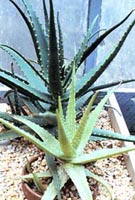Resource Library
Plant of the Week: Medicine Plant (Burn Plant)
The University of Arkansas System Division of Agriculture does not promote, support or recommend plants featured in "Plant of the Week." Please consult your local Extension office for plants suitable for your region.
Plant of the Week
Medicine Plant, Burn Plant
Latin: Aloe Vera

Having a first-aid kit handy is always a good idea, but having one that you can grow on your window sill is an exceptional notion.
Medicine Plant, Aloe vera, is probably the world’s most popular medicinal plant and well deserves the confidence people have placed in its abilities to cure the minor scrapes and cuts.
Medicine plant is a tender succulent belonging to the lily family that is native to the Mediterranean region and northern Africa. The aloes, about 180 species all together, are primarily African in origin and are either stemless like Aloe vera or trunk forming and grow like small trees. They occupy the same ecological niche that Agave occupies in our southwestern deserts. Probably before the great super continent of Pangea separated 350 million years ago, the aloes and the century plants may have shared some kinfolk.
Medicine plant grows as a flattened, two-ranked rosette which spreads outward by underground rhizomes and forms a congested cluster of fleshy leaves armed with short, soft prickles. The leaves of medicine plant are usually 8 to 10 inches long and speckled with patches of light green and gray, giving a mottled appearance. Like many succulents, its size is controlled by the amount of root room available. In small pots, plants are reduced in size.
While Aloe vera is not especially grown for its flowers, it does produce them in the wintertime in a greenhouse or outside in mild climates. The flower stem can be 2 to 3 feet tall and topped with cigar-shaped, yellow flowers about an inch long.
The medicinal properties of aloe were known by the Greeks since at least the fourth century BC. Today, they are still popularly used in a bevy of products. One company lists over 300 kinds of cosmetics, medicines and ointments that are made from various aloe extracts. The Internet is rife with get-rich-schemes involving aloe products. Most of the aloe grown commercially is from the Caribbean, south Florida or south Texas.
To collect the gum resin, the leaf is cut lengthwise and the juices extracted. The juice is evaporated and yields a crystalline glycoside called aloin which is very bitter and has been used as bitter tonic, as an aid to digestion and even to keep children from bighting their nails. If aloin is hydrolyzed, emodin is produced, which is used as a laxative.
But it’s the characteristics of the slimy juice fresh from the plant that has made medicine plant famous. A coating of fresh juice slathered on an insect bite, an abrasion, a small cut or a minor burn gives instantaneous relief from the pain. For scrapes, cuts and burns there may be an added side benefit in that the fresh juice appears to have natural bactericidal properties.
Aloe is easy to grow in any sunny window. It tolerates being pot bound for years without so much as a whimper. But if you are accident prone, it is probably best to replant occasionally to keep the plant growing so that fresh leaves can be harvested as needed.
In the summer it can be relocated to the patio or deck where it can pretty much fend for itself between rains. Overwatering has killed more aloes than drought ever was able to accomplish. When light conditions are good, fertilize monthly with a water soluble houseplant fertilizer.
By: Gerald Klingaman, retired
Extension Horticulturist - Ornamentals
Extension News - January 18, 2002
The University of Arkansas System Division of Agriculture does not maintain lists of retail outlets where these plants can be purchased. Please check your local nursery or other retail outlets to ask about the availability of these plants for your growing area.